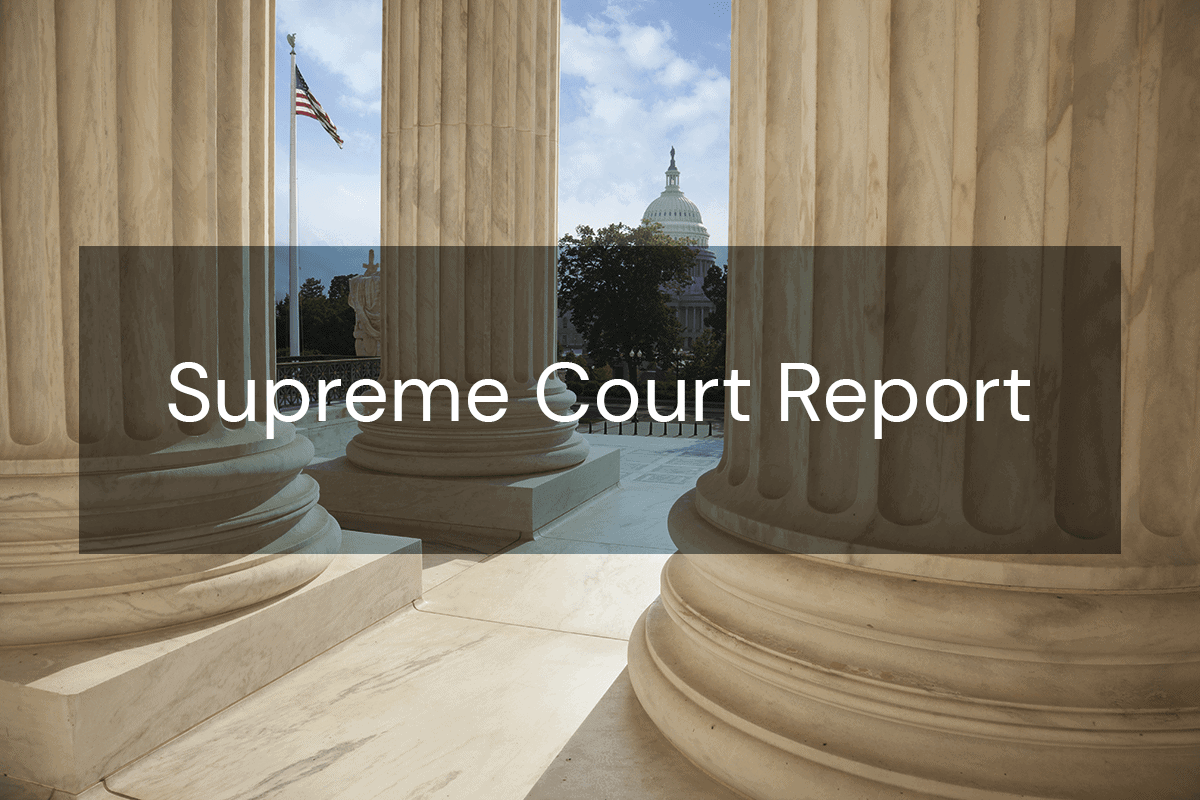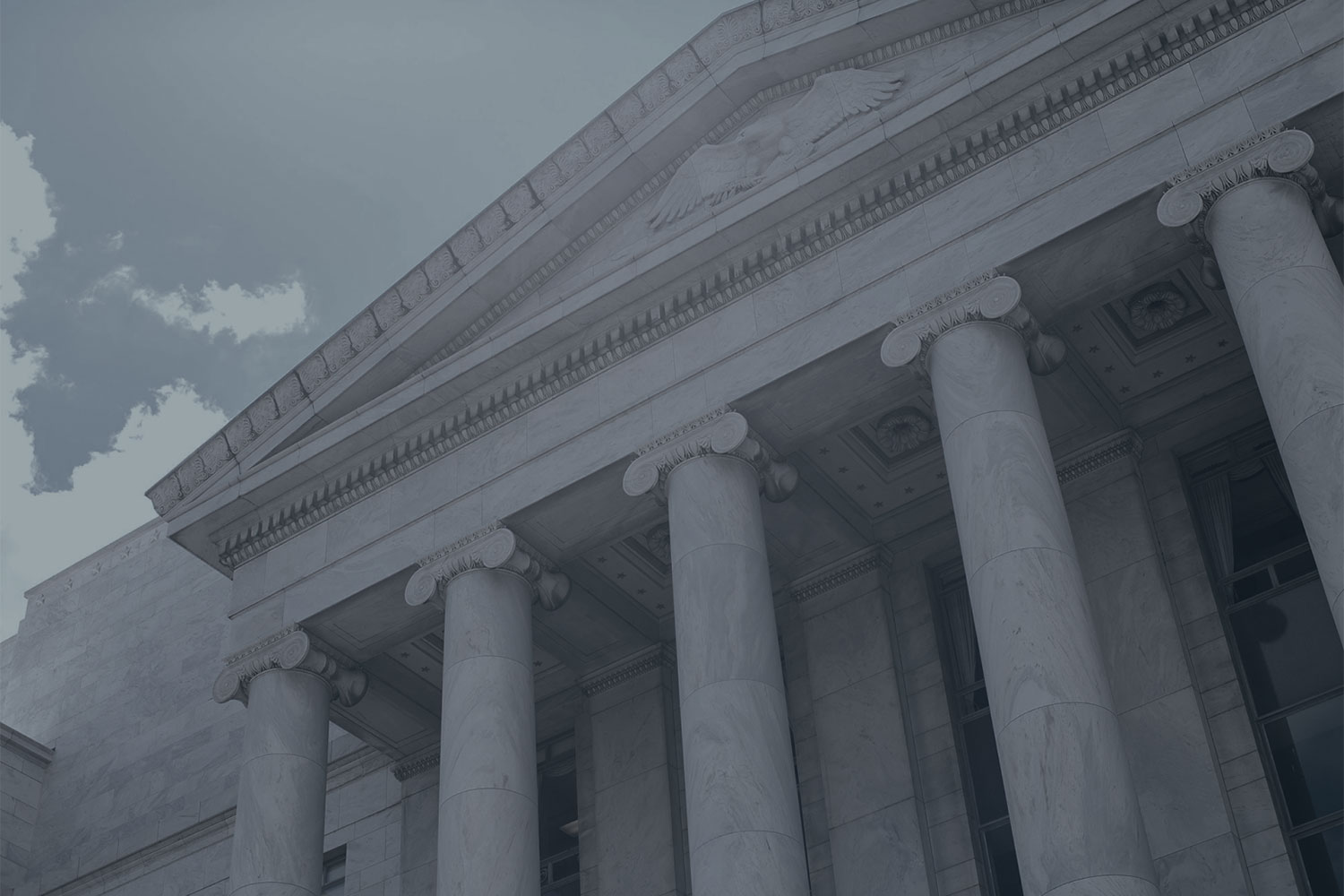Author

July 21, 2025 | Volume 32, Issue 21
This Report summarizes cases granted review on July 3, 2025 (Part I).
Cases Granted Review
Little v. Hecox, 24-38.
The question presented is “[w]hether laws that seek to protect women’s and girls’ sports by limiting participation to women and girls based on sex violate the Equal Protection Clause of the Fourteenth Amendment.” In March 2020, Idaho enacted the Fairness in Women’s Sports Act, which provides that student sports from primary school through college are designated “based on biological sex” and that sports “designated for females, women, or girls shall not be open to students of the male sex.” Respondents Lindsey Hecox and Jane Doe sued, claiming the Act violates the Equal Protection Clause and Title IX. Hecox is a transgender female who wished to compete on the Boise State University women’s track and cross-country teams; Doe was a female high-school athlete who challenged the Act’s sex-verification provision. The district court preliminarily enjoined the Act, holding that it likely violated the Equal Protection Clause. The court concluded that “the physiological differences” between males and females “do not overcome the inescapable conclusion that the Act discriminates on the basis of transgender status.” The court then held that the Act failed heightened scrutiny. The Ninth Circuit affirmed. 2023 WL 11804896.
The Ninth Circuit held that the “district court did not err in concluding that heightened scrutiny applies because the Act discriminates against transgender women by categorically excluding them from female sports.” In the Ninth Circuit’s view, “while the Act certainly classifies on the basis of sex, it also classifies based on transgender status, triggering heightened scrutiny on both grounds.” The court then held that the Act fails heightened scrutiny. The Ninth Circuit agreed “that furthering women’s equality and promoting fairness in female athletic teams is an important state interest.” But, it held, “the district court correctly determined that the Act’s means—categorically banning transgender women and girls from all female athletic teams”—was likely “not substantially related to, and in fact undermine[s], those asserted objectives.” That is because the record does not support “the conclusion that all transgender women, including those like Lindsay who receive hormone therapy, have a physiological advantage over cisgender women.”
Idaho argues in its petition that the Ninth Circuit’s decision “is egregiously wrong on a constitutional issue of deep importance: whether states can preserve fairness in women’s sports.” Idaho maintains that sex is an immutable characteristic, which “dooms any equal-protection analysis founded on the modern construct of gender identity, which was not even considered when the Equal Protection Clause was ratified in 1868.” In Idaho’s view, “[t]he Ninth Circuit wrongly supposed that a law using the traditional definition of sex imposes a sex-based stereotype. But such laws do not depend in any way on how students act or identify, but rather classify based on biological sex, which is not a stereotype.” (Quotation marks omitted.) Idaho next argues that the Ninth Circuit erred in its application of heightened scrutiny. “Idaho’s preservation of a separate space for females to compete is [] substantially related to its goals. Given how biological differences affect typical outcomes in sports, ensuring equal opportunities for biological girls in sports requires that they not have to compete against biological boys.” (Quotation marks omitted.) Finally, Idaho argues that the Ninth Circuit erred in holding that the Act discriminates based on transgender identity. Idaho notes that the law does not facially discriminate against transgender persons; it classifies based solely on sex. Nor, said the state, is the Act based on invidious motives; its purpose is to ensure equal opportunities for biological females. And, added Idaho, transgender identity does not satisfy the test for being a quasi-suspect class.
West Virginia v. B.P.J., 24-43.
This case also involves a state ban on transgender women participating in women’s and girls’ sports, this time from middle school through college. The questions presented are: (1) “Whether Title IX prevents a state from consistently designating girls’ and boys’ sports teams based on biological sex determined at birth.” (2) “Whether the Equal Protection Clause prevents a state from offering separate boys’ and girls’ sports teams based on biological sex determined at birth.” At issue is West Virginia’s Save Women’s Sports Act, which provides that girls’ sports teams based on “competitive skill” or “involv[ing] a. . . contact sport” should not be open to biological males. “Male” and “female” are defined by the student’s “reproductive biology and genetics at birth.”
Before the law took effect, respondent B.P.J.―a then-11-year-old biological male who identifies as female―sued, arguing that the Act violates Title IX and the Equal Protection Clause. The district court preliminarily enjoined the Act. While that injunction was in effect, B.P.J. competed on the girls’ cross country and track-and-field teams, “routinely defeating and displacing female athletes.” After a fuller record developed, the district court entered summary judgment for the state and other defendants (collectively, the state). “The district court found no genuine dispute that biological males have physiological advantages over biological females. These ‘inherent’ advantages . . . mean that ‘biological males . . . are not similarly situated to biological females’ in sports.” The Fourth Circuit reversed and remanded in part. 98 F.4th 542.
On the equal protection claim, the Fourth Circuit held that the Act constituted “a facial classification based on gender identity” that triggered intermediate scrutiny. The court then ruled that the state “must defend the Act as applied to B.P.J.’s particular circumstances, defining the relevant comparator as a female who has not ‘undergo[ne] Tanner 2 stage puberty’ participating in girls’ cross-country. After setting these rules, the majority remanded the claim because it found a dispute over whether certain males ‘enjoy a meaningful competitive athletic advantage over cisgender girls.’” (Citation omitted.) On the Title IX claim, the Fourth Circuit ruled for B.P.J., holding that the Act discriminated on the basis of sex in violation of Title IX. The court reasoned “that adverse treatment on the basis of transgender status is necessarily adverse treatment based on sex. It further explained that H.B. 3293 treated B.P.J. worse than similarly situated students, by not allowing her to play on the girls’ team because of her sex designated at birth. The court concluded that B.P.J. is similarly situated to other girls, including due to her longstanding identity as a girl, her social transition, her school gender support plan, her name change and updated identity documents, and her medical treatments.” (Citations omitted.)
The state argues in its petition that the Fourth Circuit erred on both issues. Starting with Title IX, the state maintains that its “ordinary meaning in 1972 is clear: the ‘overwhelming majority of dictionaries defin[ed] sex on the basis of biology and reproductive function.’ As this Court stated just one year after Congress passed Title IX, ‘sex’ is ‘an immutable characteristic’ determined by ‘birth.’” (Citation omitted.) “In short,” says the state, “’it would require blinders to ignore that the motivation for promulgation of the regulation on athletics was the historic emphasis on boys’ athletic programs to the exclusion of girls’ athletic programs in high schools as well as colleges’.” The state maintains that Bostock v. Clayton Cnty., 590 U.S. 644 (2020), does not require a different result, for Bostock counseled against applying its reasoning beyond Title VII, and Title VII and Title IX have different texts and contexts.
On the equal protection issue, the state asserts that “[u]nder the Sports Act, everyone born male competes on male or coed public-school teams—no matter whether they identify as male, female, nonbinary, or one of the other dozens of genders that students might adopt. The Act, then, is deliberately indifferent to the question of gender identity, hinging instead on sex—’an immutable characteristic determined solely by the accident of birth.’” The Fourth Circuit therefore erred, says the state, by insisting that the Act discriminated based on transgender status. The state also criticizes the Fourth Circuit’s as-applied analysis, saying it “requir[ed] the State to explain how the Act advances substantial interests in B.P.J.’s specific circumstances. This approach will compel lower courts to apply a strict-scrutiny-style standard in every as-applied constitutional challenge.”
Galette v. N.J. Transit Corp., 24-1021;
N.J. Transit Corp. v. Colt, 24-1113.
The Court consolidated the two cases and limited the grant of certiorari to the following question: “Whether the New Jersey Transit Corporation is an arm of the State of New Jersey for interstate sovereign immunity purposes.” The New Jersey Legislature created New Jersey Transit Corp. (NJ Transit) in 1979 to operate New Jersey’s public-transportation system. NJ Transit runs a network of statewide bus, rail, and light-rail services extending across the state and into Pennsylvania and New York. The legislature stated that NJ Transit is “constituted as an instrumentality of the State exercising public and essential governmental functions,” and that the exercise of its powers is “an essential governmental function of the State.” The Governor appoints each member of NJ Transit’s 13-member board. NJ Transit may sue and be sued, including by retaining outside legal counsel of its own choosing; and it can raise funds from fares, gifts, grants, or loans. In addition, “[a]ll expenses incurred by” NJ Transit “in carrying out the provisions of” its organic act “shall be payable from funds available to the corporation” through its own fare collections and fundraising, and “[n]o debt or liability of the corporation shall be deemed or construed to create or constitute a debt, liability, or a loan or pledge of the credit of the State.” The highest courts of Pennsylvania and New York have reached conflicting decisions on whether NJ Transit is an arm of the state of New Jersey.
The Pennsylvania case began in August 2018, when Cedric Galette sued NJ Transit and Julie McCrey, alleging that he was a passenger in a vehicle operated by McCrey “when NJ Transit struck the vehicle” while the vehicle was stopped on a Philadelphia road. NJ Transit responded that it is an arm of the State of New Jersey entitled to interstate sovereign immunity. The trial court denied the motion; the superior court affirmed; but the Pennsylvania Supreme Court reversed. 2024 WL 5457879. The Pennsylvania Supreme Court relied on the following considerations: (1) NJ Transit was created to “provide for the operation and improvement of a coherent public transportation system,” which New Jersey believes to be an “essential governmental function[]”; (2) the statute “establishes a NJ Transit Police Department”; (3) the statute “permits NJ Transit to acquire land and property by means of eminent domain”; and (4) “the political branches of the State of New Jersey exercise a significant degree of control over NJ Transit.” The court concluded that these factors outweigh the facts that “NJ Transit may raise its own private and public funds, acquire and dispose of real property, and collect fares.” Galette insists that NJ Transit is not an arm of the state, for it “bears the characteristics of an independent political subdivision, not a government agency exercising core, traditional state powers as an ‘alter ego’ of the State itself.”
The New York case began in September 2017, when respondents Jeffrey Colt and Betsy Tsai sued NJ Transit in New York state court, alleging that an NJ Transit bus driven by Ana Hernandez negligently struck Colt in Manhattan. NJ Transit moved to dismiss the case based on sovereign immunity. The case made its way up to the New York Court of Appeals, which held that NJ Transit is not an arm of the State of New Jersey. 2024 N.Y. Slip Op. 05867. In reaching that conclusion, the New York Court of Appeals emphasized that New Jersey law “disclaimed any legal liability for judgments against [NJ Transit].” The court thus held that “allowing this suit to proceed would not be an affront to New Jersey’s dignity.” In its petition, NJ Transit argues that “[t]he New York Court of Appeals gave too much weight to the treasury factor—the formal financial impact of a judgment against NJ Transit on the State. Doing so offended this Court’s precedents and core principles of sovereign immunity.” In particular, excessive focus on the treasury factor means a court “fail[s] to capture harms to each State’s dignity and coequal status that interstate sovereign immunity law exists to protect.”
Olivier v. City of Brandon, MS, 24-933.
In Heck v. Humphrey, 512 U.S. 477 (1994), the Court established a bar against §1983 claims that necessarily imply the invalidity of the plaintiff’s criminal conviction. At issue here are (1) whether “Heck v. Humphrey bars §1983 claims seeking purely prospective relief where the plaintiff has been punished before under the law challenged as unconstitutional”; and (2) whether “Heck v. Humphrey bars §1983 claims by plaintiffs even where they never had access to federal habeas relief.” Petitioner Gabriel “Olivier is a Christian who often shares his faith on public streets in the city of Brandon, Mississippi.” He did this by passing out religious literature and engaging people in conversation. And he sometimes did so near a city amphitheater that hosts live events. In 2019, the city enacted an ordinance restricting “protests” and “demonstrations” near the amphitheater to a designated area in the hours surrounding an event. Two years later, Olivier violated the ordinance, and the city charged Olivier with that offense. Olivier entered a no-contest plea and received a sentence of 10 days’ suspended imprisonment and a $304 fine. Olivier paid the fine and didn’t appeal. A few months later, Olivier filed a §1983 action against the city and police chief, arguing that the ordinance violated the First and Fourteenth Amendments. He sought only prospective injunctive relief. Based on Fifth Circuit precedent, the district court granted summary judgment to the city, holding that Heck barred Olivier’s claims. A Fifth Circuit panel affirmed. 2023 WL 5500223.
The Fifth Circuit panel explained that, “[t]hough a classic example of a Heck-barred claim is one for money damages, courts have expanded Heck to also bar declaratory and injunctive relief. See Wilkinson v. Dotson, 544 U.S. 74, 81-82 (2005)[.]” Further, in a prior decision, the Fifth Circuit had reasoned that even a ruling on a claim for prospective relief implicates Heck “because a favorable ruling ‘would be binding on state courts,’ which ‘could only conclude that [the inmate] had been convicted of violating an unconstitutional rule.’” In short, a decision for Olivier here would necessarily imply the invalidity of his prior conviction―regardless of the relief Olivier seeks. By a 9-8 vote, the Fifth Circuit denied en banc relief.
Olivier argues in his petition that, “[t]ypically, Heck bars a civil suit that seeks retroactive relief from the burdens of a prior conviction. In Heck itself, for example, the plaintiff brought a §1983 suit based on an allegedly unlawful arrest and sought damages, not prospective relief. That challenge was, in effect, an impermissible ‘collateral attack’ on a conviction. By contrast, claims for future [injunctive] relief are distant from Heck’s core.” (Citation and quotation marks omitted.) Olivier continues, “By their very nature, [i]njunctions do not work backwards to invalidate official actions taken in the past. Rather, they operate to prevent future official enforcement actions upon threat of contempt.” (Quotation marks omitted.) Olivier adds that “Heck embodies a judicial accommodation of two competing statutes—the federal habeas statute and §1983. But here, there’s no overlap. Olivier’s prospective-relief claim doesn’t allege that he was or is ‘in custody in violation of’ the First Amendment.” And “where, as here, a plaintiff seeks to preclude an unconstitutional confinement in the future, arising from incidents occurring after any prior conviction and stemming from a possible later prosecution and conviction, Heck’s purposes aren’t jeopardized.” (Quotation marks omitted.) Olivier’s second question presented is based on the Fifth Circuit’s rejection of Olivier’s argument that “Heck doesn’t bar his §1983 suit on the alternative, independent basis that he was never in custody and, as a result, habeas was never available to him—so Heck has no role to play because there’s no overlap between §1983 and the habeas statute.”
NAAG Center for Supreme Court Advocacy Staff
- Dan Schweitzer, Director and Chief Counsel
The views and opinions of authors expressed in this newsletter do not necessarily state or reflect those of the National Association of Attorneys General (NAAG). This newsletter does not provide any legal advice and is not a substitute for the procurement of such services from a legal professional. NAAG does not endorse or recommend any commercial products, processes, or services. Any use and/or copies of the publication in whole or part must include the customary bibliographic citation. NAAG retains copyright and all other intellectual property rights in the material presented in the publications.




